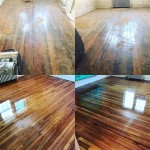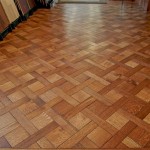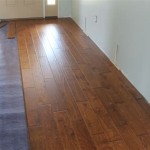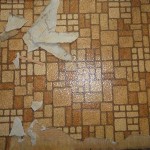How To Install Vinyl Plank Flooring On Concrete Basement Floor
Installing vinyl plank flooring on a concrete basement floor is a popular and cost-effective way to transform a cold, uninviting space into a comfortable and stylish living area. Vinyl plank flooring is known for its durability, water resistance, ease of maintenance, and relatively simple installation process, making it a particularly suitable choice for below-grade environments prone to moisture. However, successful installation requires careful preparation and attention to detail to ensure a long-lasting and aesthetically pleasing result. This article provides a comprehensive guide to installing vinyl plank flooring on a concrete basement floor, covering essential preparation steps, installation techniques, and best practices.
Key Point 1: Assessing and Preparing the Concrete Subfloor
The foundation of any successful flooring installation is a properly prepared subfloor. The concrete basement floor must be thoroughly assessed and prepared to ensure optimal adhesion and prevent future problems like moisture damage or unevenness that can cause the vinyl plank to buckle or separate.
Moisture Testing: Concrete inherently wicks moisture from the ground. Before any flooring is installed, it’s crucial to test the moisture content of the concrete slab. Excessive moisture can compromise the adhesive and lead to mold growth under the flooring. Several methods can be employed:
- Calcium Chloride Test (Moisture Vapor Emission Rate Test): This is considered the most accurate method. A measured amount of calcium chloride is placed under a sealed dome on the concrete surface for a specified period (usually 72 hours). The amount of moisture absorbed by the calcium chloride is then measured and expressed as pounds of moisture emitted per 1,000 square feet per 24 hours. Consult the vinyl plank manufacturer's specifications for acceptable moisture emission rates.
- Relative Humidity (RH) Test: This involves drilling small holes into the concrete and inserting a probe that measures the relative humidity within the slab. Again, refer to the vinyl plank manufacturer's specifications for acceptable RH levels.
- Plastic Sheet Test: A simpler, less precise method involves taping a square of clear plastic sheeting (at least 18x18 inches) to the concrete floor and sealing all the edges with tape. After 24-72 hours, examine the plastic sheet for condensation. If condensation is present, the concrete likely has excessive moisture.
If moisture levels exceed the vinyl plank manufacturer's recommendations, it is imperative to address the moisture issue before proceeding. This may involve applying a moisture barrier coating to the concrete surface, improving drainage around the foundation, or installing a dehumidifier to reduce ambient humidity. Consult with a flooring professional or concrete specialist for appropriate solutions.
Cleaning and Repairing the Concrete Surface: The concrete floor must be thoroughly cleaned to remove dirt, dust, grease, paint, adhesives, or any other debris that could interfere with the adhesion of the vinyl plank. A thorough sweeping and vacuuming are essential. Follow this with scrubbing the surface with a mild detergent and water solution. For stubborn residues, consider using a concrete degreaser or adhesive remover. Rinse thoroughly and allow the floor to dry completely before proceeding.
Inspect the concrete floor for cracks, holes, and unevenness. Small cracks (less than 1/8 inch wide) can typically be filled with a concrete crack filler or patching compound. Larger cracks should be repaired by a professional. Leveling compound should be used to fill in low spots and create a smooth, even surface. Ensure that the leveling compound is fully cured and dry before installing the vinyl plank flooring. A self-leveling underlayment can be added for extreme unevenness on the concrete surface.
Acclimation of Vinyl Plank Flooring: It is crucial to acclimate the vinyl plank flooring to the room's temperature and humidity before installation. This allows the planks to expand or contract to their natural size, minimizing the risk of gaps or buckling after installation. Store the boxes of vinyl plank flooring in the basement room for at least 48-72 hours, ideally with the boxes open to allow for better air circulation. Follow the manufacturer's recommendations for specific acclimation guidelines.
Key Point 2: Selecting the Right Tools and Materials
Having the right tools and materials on hand will streamline the installation process and ensure a professional-looking result. Here's a comprehensive list of essential items:
Tools:
- Measuring Tape: For accurate measurements of the room and planks.
- Utility Knife: For scoring and cutting vinyl planks.
- Straight Edge or T-Square: For making precise cuts.
- Rubber Mallet: For gently tapping planks together and ensuring a tight fit.
- Spacers: To maintain a consistent expansion gap around the perimeter of the room.
- Pencil: For marking cutting lines on the planks.
- Safety Glasses: To protect eyes from debris.
- Knee Pads: To provide comfort while working on the floor.
- Hand Saw or Jigsaw (Optional): For more intricate cuts around doorways or pipes.
- Moisture Meter: to confirm the moisture levels of the concrete.
Materials:
- Vinyl Plank Flooring: Choose a high-quality vinyl plank flooring specifically designed for basement applications. Look for options that are waterproof or water-resistant and have a durable wear layer.
- Underlayment (Optional but Recommended): While some vinyl plank flooring comes with a pre-attached underlayment, adding a separate underlayment can provide additional benefits, such as increased sound insulation, improved thermal insulation, and added moisture protection. Choose an underlayment specifically designed for use with vinyl plank flooring and concrete subfloors.
- Moisture Barrier (If Necessary): If moisture testing reveals excessive moisture levels in the concrete, a moisture barrier coating or membrane may be required.
- Adhesive (If Required): Some vinyl plank flooring requires adhesive for installation. Choose an adhesive recommended by the manufacturer and specifically formulated for use with vinyl plank flooring and concrete subfloors.
- Transition Strips/Molding: For transitioning between different flooring types or covering expansion gaps around the perimeter of the room.
- Construction Adhesive: to adhere transition strips.
Key Point 3: Installing the Vinyl Plank Flooring
With the subfloor properly prepared and the necessary tools and materials gathered, the installation process can begin. Careful execution and attention to detail are essential for a professional-looking and long-lasting result.
Planning the Layout: Before beginning the installation, it’s crucial to plan the layout of the vinyl planks. Start by measuring the room and determining the direction in which the planks will be laid. Consider the position of doorways, windows, and other architectural features. It’s generally recommended to lay the planks parallel to the longest wall of the room to create a sense of spaciousness. Additionally, plan the layout to minimize the amount of cutting required, especially around obstacles. A dry-fit of the first few rows of planks can help visualize the layout and identify any potential challenges.
Starting the First Row: Begin by placing spacers along the wall to create an expansion gap (typically ¼ to 3/8 inch). The first row of planks should be positioned with the tongue side facing the wall. If using adhesive, apply it according to the manufacturer's instructions, typically in small sections to prevent it from drying out before the planks are installed. Carefully align the first plank and press it firmly into place. Continue laying the planks in the first row, clicking or locking them together according to the manufacturer's instructions. Use a rubber mallet to gently tap the planks together and ensure a tight fit.
Cutting and Fitting Planks: As you reach the end of each row, you will likely need to cut planks to fit. Measure the required length and use a utility knife and straight edge to score the plank. Then, snap the plank along the scored line. For more intricate cuts, such as around pipes or doorways, use a handsaw or jigsaw. When cutting planks, always wear safety glasses to protect your eyes from debris.
Continuing the Installation: Continue laying the planks row by row, staggering the end joints to create a more visually appealing and structurally sound floor. Staggering the joints also helps to distribute stress across the floor and prevent the formation of weak spots. Use spacers along the walls to maintain a consistent expansion gap. Regularly check the alignment of the planks to ensure that they are straight and level.
Installing Around Obstacles: When installing around obstacles, such as pipes or doorways, carefully measure and cut the planks to fit. Use a template or cardboard to create an accurate pattern for the cuts. Leave a small expansion gap around the obstacle to allow for movement. Consider using a transition strip or molding to cover the gap and create a clean, finished look.
Finishing the Installation: Once all the planks have been installed, remove the spacers and install transition strips or molding around the perimeter of the room and in doorways. Transition strips help to protect the edges of the flooring and create a smooth transition between different flooring types. Use construction adhesive or nails to secure the transition strips in place. Clean the floor thoroughly to remove any dust or debris. Allow the adhesive to cure completely before placing furniture or heavy objects on the floor.
By following these steps carefully and paying attention to detail, one can successfully install vinyl plank flooring on a concrete basement floor and transform the space into a comfortable and stylish living area. Remember to always consult the manufacturer's instructions for specific recommendations and guidelines related to their product.

How To Install Vinyl Or Laminate Floors In A Basement Over Concrete Slab

Tips For Installing Vinyl Plank Over Concrete Floors Lemon Thistle

Best How To Install Vinyl Plank Flooring Four Generations One Roof

Best How To Install Vinyl Plank Flooring Four Generations One Roof

Laminate Flooring On Concrete Basement Floors Expert Installation Guide Csg Renovation

Best How To Install Vinyl Plank Flooring Four Generations One Roof

Tips For Installing Vinyl Plank Over Concrete Floors Lemon Thistle

Ep5 Finishing A Basement How To Install Vinyl Plank Flooring Diy

Vinyl Plank Flooring Installation Basement Remodel Before And After

Concrete Subfloor Preparation For The Vinyl Floor Installation How To Diy Mryoucandoityourself
Related Posts








